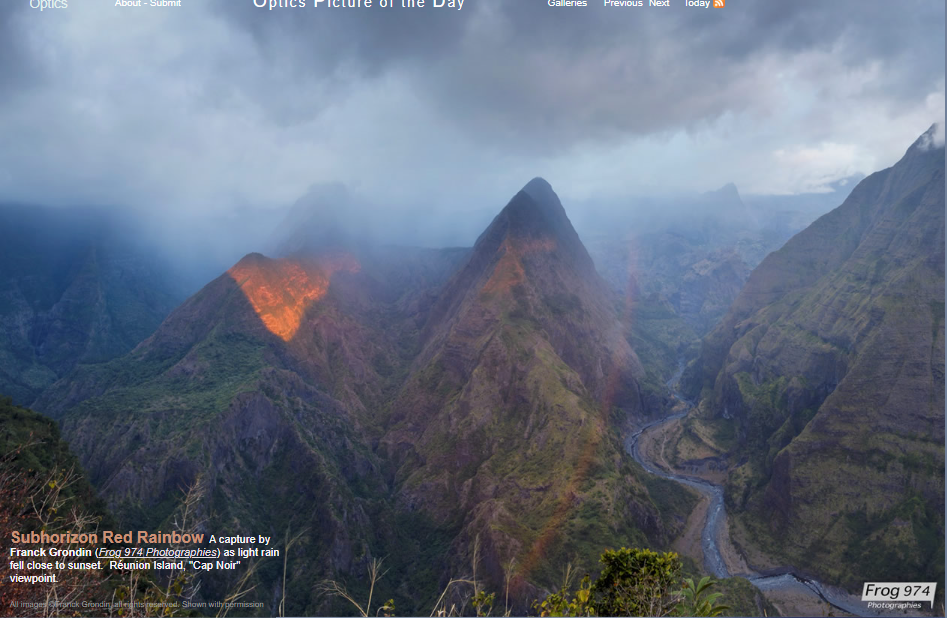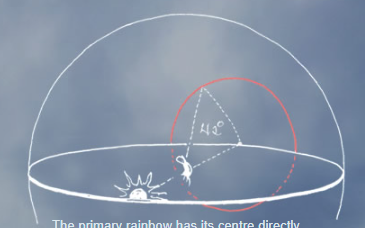Subhorizon Red Rainbow, Réunion Island - OPOD
Subhorizon Red Rainbow, Réunion Island - OPOD
Have you ever witnessed the enchanting sight of a subhorizon red rainbow? These rare occurrences are truly mesmerizing, captivating the eyes of those lucky enough to witness them. Picture this: a gentle rain falls as the sun sets, casting its warm, golden light across the landscape. It is in this magical moment that the subhorizon red rainbow reveals itself, painting the sky with vibrant hues of red. One such breathtaking capture was made by Franck Grondin (Frog 974 Photographies) on Réunion Island at the "Cap Noir" viewpoint. Let's delve deeper into the phenomenon of subhorizon red rainbows and unravel their captivating secrets.
The Magic of Red Bows
Subhorizon red rainbows are often observed near sunset or dawn. During these times, when the sun is still illuminating high falling rain, we are treated to the spectacle of exceptionally red bows. The reason behind their intense red color lies in the path sunlight takes through the atmosphere. As the sun sets, its rays travel through a greater amount of air before reaching our eyes. Along this extended journey, air molecules scatter away shorter wavelengths of light such as violets, blues, and greens. What remains are highly reddened rays that create the striking red rainbow we see.
Factors Influencing Appearance
While the scattering of light by air molecules plays a significant role in the formation of subhorizon red rainbows, other factors also influence their appearance. Dust particles, aerosols, atmospheric moisture, and even the rainbow's background can all contribute to the unique characteristics of each rainbow. These elements interact with the sunlight and raindrops, adding complexity and diversity to the visual display. Consequently, every subhorizon red rainbow possesses its own distinct personality, making each encounter a truly one-of-a-kind experience.
The Elusive Sub Horizon Bows
One intriguing aspect of subhorizon red rainbows is their circular shape. In ideal conditions, where there is an abundant supply of raindrops in the right directions, rainbows can form a complete circle. However, when observing from level ground, the path length from the eye to the ground is often too short to include a sufficient number of rainbow-forming raindrops. As a result, only a faint bow may be visible. But fear not! By ascending a hill or mountain, or even standing on the rim of the Grand Canyon, you position yourself in a location where there is a plentiful supply of rain along the rainbow cone. From this vantage point, you increase your chances of witnessing a more pronounced and awe-inspiring subhorizon red rainbow.
Exploring the Subtleties
Subhorizon red rainbows are captivating phenomena that have fascinated scientists and observers for centuries. While their general characteristics have been studied and understood, there is still much to uncover about the intricacies of these elusive rainbows. By delving deeper into their formation and exploring the subtleties of their appearance, we can gain a greater appreciation for the beauty and complexity of the natural world.
A Symphony of Colors
One cannot discuss subhorizon red rainbows without acknowledging the breathtaking palette of colors they exhibit. While red is the dominant hue, it is not uncommon to witness additional shades and tints. The specific color variations depend on various factors such as the size and shape of the raindrops, the angle at which sunlight interacts with them, and the atmospheric conditions present during the rainbow's formation. These factors create a symphony of colors that dance across the sky, captivating our imagination and reminding us of the wonders that exist beyond our everyday perception.
Capturing Nature's Masterpiece
Photographers, like Franck Grondin, have a keen eye for capturing nature's masterpieces. Their skill and dedication allow us to experience the beauty of subhorizon red rainbows even if we are not physically present. Through their lens, they freeze these fleeting moments in time, preserving them for eternity. These photographs not only serve as a visual record but also inspire us to seek out and appreciate the hidden wonders that surround us.
The Subhorizon Red Rainbow - A Sight to Behold
In conclusion, the subhorizon red rainbow is a truly extraordinary sight that unveils itself during the fleeting moments of sunset or dawn. As the sun's rays interact with falling rain, a symphony of colors emerges, dominated by vibrant red hues. While these rainbows are often elusive and challenging to observe from level ground, venturing to higher vantage points provides a greater chance of witnessing their awe-inspiring beauty. Subhorizon red rainbows are a testament to the complex interplay between sunlight, raindrops, and atmospheric conditions. They remind us of the profound mysteries that lie within the natural world and invite us to pause, appreciate, and marvel at the wonders that surround us.

Subhorizon Red Rainbow A capture by Franck Grondin (Frog 974 Photographies) as light rain fell close to sunset. Réunion Island, "Cap Noir" viewpoint.
All images ©Franck Grondin, all rights reserved. Shown with permission
Red Bows
See them near to sunset and dawn.
Sometimes very red bows are seen just before sunrise or after sunset when the sun is still illuminating high falling rain.
Sunset sunlight travels through much more air before reaching us. Air molecules scatter away more violets, blues and greens leaving highly reddened rays to make the rainbow.
Dust, aerosols, atmospheric moisture and the rainbow's background also influence the appearance.
Every rainbow is different in its own way.

The primary rainbow has its centre directly opposite the sun. At sunset or sunrise the bow is at its greatest possible height.
At sun heights above 42° the entire bow is beneath the horizon
Sub Horizon Bows
All rainbows are circular (or nearly so). They will form a full circle if allowed by plentiful raindrops in the right directions.
On level ground the path length from the eye to ground is not long enough to include enough rainbow forming raindrops. At most a faint bow is seen.
Climb a hill or mountain or stand on the Grand Canyon rim and there is a plentiful supply of rain along the rainbow cone.

Note: this article has been automatically converted from the old site and may not appear as intended. You can find the original article here.
Reference Atmospheric Optics
If you use any of the definitions, information, or data presented on Atmospheric Optics, please copy the link or reference below to properly credit us as the reference source. Thank you!
-
<a href="https://atoptics.co.uk/blog/subhorizon-red-rainbow-r-union-island-opod/">Subhorizon Red Rainbow, Réunion Island - OPOD</a>
-
"Subhorizon Red Rainbow, Réunion Island - OPOD". Atmospheric Optics. Accessed on April 25, 2024. https://atoptics.co.uk/blog/subhorizon-red-rainbow-r-union-island-opod/.
-
"Subhorizon Red Rainbow, Réunion Island - OPOD". Atmospheric Optics, https://atoptics.co.uk/blog/subhorizon-red-rainbow-r-union-island-opod/. Accessed 25 April, 2024
-
Subhorizon Red Rainbow, Réunion Island - OPOD. Atmospheric Optics. Retrieved from https://atoptics.co.uk/blog/subhorizon-red-rainbow-r-union-island-opod/.